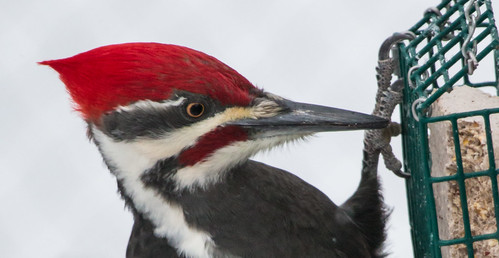 |
| The male Pileated Woodpecker of our neighborhood in one of my feeders. |
On Thursday afternoon, my doorbell rang. It was the boy next
door—he looked SO excited as he told me that there was a “giant woodpecker with
big red feathers on its head!” His friend was on the sidewalk, facing away from
us, and I suddenly realized he was keeping watch on the Pileated Woodpecker.
Just a second or two later, the bird took off. The three of us watched it
flying low across a few front yards, and it lit in a big tree a few doors
down. The boys are hoping to spy on it to find out where it sleeps.
Then on Saturday, I got an email from my friend Lisa Johnson, who had photographed a pair
of Pileated Woodpeckers in a tree in her backyard in a different neighborhood that week.
Since it was so close to Valentine’s Day, Lisa naturally started speculating
about whether they were getting romantic, as Great Horned Owls are wont to at
this time of year. But romantic feelings are not yet stirring in the Pileated
heart—at least not in any kind of call to action. Females won’t start
laying eggs until May, and both male and female hormone levels are still at low
ebb, though they're starting to rise. But in the dead of winter, especially during a cold snap like we had last week,
the males and females can’t afford to focus on anything much except food.
Two Pileated Woodpeckers; photo by Lisa Johnson
|
So what were they doing together? Pileated Woodpeckers usually
mate for life, though they’re only “romantic” during a very brief window of
time in late winter and spring—at least romantic in the sense of coming together in the way we
think of birds and bees and human valentines doing it. The rest of the year
their relationship is strictly platonic. The truth is, woodpeckers, chickadees,
and many other birds practice a very strict form of the rhythm method. And because
their hormones and sex organs atrophy except during the mating season, they
don’t feel the least bit deprived.
Most birds lead lives that are extremely rhythmic. As happy
as I feel to notice the sun rising earlier and setting later each day, I don’t
have the profound visceral sense of changing day length that birds have. Our
human civilization has focused for millennia on severing those very natural
rhythms. Fire in caves, candles in increasingly sophisticated houses, kerosene
lanterns, and electrical lighting have incrementally severed our innate rhythm
of sleeping after dark and waking with the sunrise. Of course, remnants of that
innate rhythm may still have contributed to our selecting a day in mid-February, right when day length is noticeably increasing, as a romantic holiday, just as our holidays in the darkest parts of the year
involve candles and lights. Despite our electrical lighting indoors and out, we
can’t help but sense the longest nights and then the increasing day length.
Increasing day length is already affecting Pileated
Woodpeckers, even if it hasn’t made them completely twitterpated yet. Some
pairs are more tightly bonded than others—there are cases of divorce, where one
individual abandons its mate in winter, and some pairs spend more time
throughout winter near each other than other pairs. They virtually always stick
to their territory year-round, and from about mid-February through March and
April, they seem to find themselves near each other more and more, until the
changing diet as spring progresses and that ever-increasing day length push
their hormonal levels to the precise point where they are physiologically prepared to do what birds and bees and educated fleas do.
Pileateds tend to be pretty secretive when actually mating, but I've got my fingers crossed that Lisa and the little boy and his buddy next door have good luck tracking these thrilling birds, and that the birds have even better luck making new little Pileated Woodpeckers that can grace our neighborhoods for many years to come.

